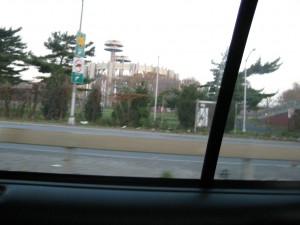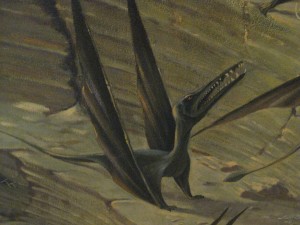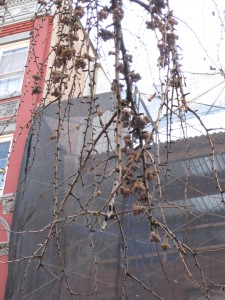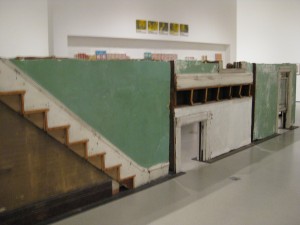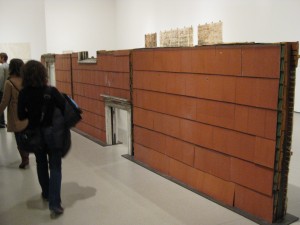An island sixteen miles long, solid-founded, numberless crowded streets, high growths of iron, slender, strong, light, splendidly uprising toward clear skies…
(Walt Whitman – Mannahatta)
New York City, no matter how often one visits, never ceases to astonish. There is something hyperbolic about it, a daily tyranny of choice that ceaselessly inflicts itself upon the limits of one’s time and energy. At times it feels like a giant, hissing concrete lung; its people and vehicles seething around like blood corpuscles, clotting together and erupting again into vast, bubbling streams. I’ve fallen in and out of love with the place many times; sometimes even on the same day; at once oppressed and elated by it, my mind hovering in a tension of opposites, among the American buildings, American streets, beneath the American sky. I’m always struck by the absence of coniferous trees here, save for the living fossil gingkos, which everywhere line the avenues, the sour stench of their prehistoric fruits wafting up from rain-glistened pavement. Sharing the streets are legions of Gleditsias and Chinese Scholar trees, rattling their naked branches against the filigreed backdrop of overhead wires and converging contrails, all glowing orange in the soft winter sun.
Art is the main reason I’m here. In contrast to what it is on offer in New York, Canadian art institutions seem perpetually measly. Yet it was ever thus. Even the biggest of Canadian burgs seems like a Siberian outpost compared to Manhattan’s great ship of skyscrapers looming on the Hudson. Canada isn’t exactly rife with New York’s hyper-kinetic energy either. At crosswalks, we stolidly wait for the traffic lights to change before mincing cautiously out into the intersection, we dutifully sanitize our hands at every public opportunity, and bottle up our just Canadian outrage until we have time to write a snippy letter to the Globe and Mail. I love my country but holy crap can it be boring! Well at least we don’t have to worry about being overstimulated. But back to ART… Because (in New York) you can take the existence of art for granted, it is possible to engage with work here that pushes the envelope of what art *is*. This is the liminal l ‘m most interested in and during my latest trip there, I was richly rewarded.
Take for example the work of Trevor Paglen on show as part of the New Museum’s Free exhibition. Paglen does amazing work documenting the so called ‘black’ world of military surveillance technology, which is deployed all around us but isn’t meant to be noticed, unless like Paglen and the amateur astronomy geeks he hangs out with, you know where to look. A couple of his photographs are described this way:
In They Watch the Moon, 2010, Paglen captures a surveillance station run by the NSA and the Navy in a part of West Virginia known as the US National Radio Quiet Zone, in which no electromagnetic radiation is permitted. While officially this is to prevent interference with the nearby Green Bank Observatory, it also services this radio telescope spying station, which was originally constructed to pick up telephone and other radio signals on the other side of the planet as they are transmitted out into space and bounce off of the moon. Paglen captures the site at night, glowing under the light of a full moon.
In Dead Military Satellite (DMSP 5D-F11) Near the Disk of the Moon (2010), Paglen captures a dead military satellite as it is about to cross the disk of the moon. In PAN (Unknown; USA-207), an array of stars is made visible using time-lapse photography as they streak across the night sky. Looking closer toward the center of the image there is a cluster of stationary dots that do not move along with the other stars. These are communications satellites that have been positioned in a narrow ring of orbit called the Clarke Belt, in which objects move at the exact speed of the earth‘s rotation and thus appear stationary above a particular global point. While these satellites are used for all kinds of communication, both commercial and military, the second dot from the left of the central cluster is a secret, unregistered satellite known as Pan, or Palladium at Night, hovering above Somalia and the Middle East. The image was captured in South Africa with the aid of amateur astronomers.
The set of essays written to accompany Free provides some fresh analysis on the redefinition of public space emerging from the seething foment of networked communication in which we now live. The internet bathes us in information while at the same time acting as a receptacle for our thoughts, combining and recombining our utterances with those of others in strange new configurations that are then fed back to us. This twitchy interplay is the core concept of Free. Its curatorial hand never gets too didactic; instead we are given an engaging snapshot of the constantly changing informational landscape, which artists are simultaneously responding to and creating.
Charles Le Dray whose has a vast show at the Whitney, doesn’t challenge the nature of how we communicate with each other per se but rather how we connect to the objects in our everyday life. Le Dray, a master tailor, has packed several galleries with tiny outfits of clothing; exquisitely sewn, midget versions of what one might find hanging in any dry cleaning store, complete en masse with tiny wire coat hangers with even the little paper sleeves on them that say: “We ♥ our customers!” The combined effect is that of stumbling into an abandoned Lilliput; “Who were these tiny people?” and “Where did they all go?” Le Dray re-imagines clothing even further, fashioning what one might call ‘meta-clothing’ from human-sized jackets with swarms of tinier outfits erupting from the lining like budding hydras or the parthenogenetic aphids, who carry their own daughters and granddaughters inside them like nested Russian dolls. Or perhaps LeDray conceived this piece as a kind of parasitism, the little outfits fattening themselves on the nutritious fabrics of their larger sartorial cousins. In any case, it feels very biological. There is something enchanting about the fastidiousness and quality of obsessive iteration that Le Dray employs and he achieves this with the other materials he uses well, such as the tiny pottery vessels he has arranged in serried ranks in glass display cases and a set of astonishingly detailed, miniature models he has carved from human bone; a stalk of wheat, a cobbler’s bench and an orrery complete with miniscule planets arranged on hair thick shafts around a tiny ersatz sun.
Yoshitomo Nara, (whose work was at Asia Society) exists in another kind of feedback loop with the pop culture he simultaneously fetishizes and also influences. Nara is one of the leading proponents of the kowa kawaii (creepy cute) aesthetic that has been spilling out of Japan over the past years. His images of switch-blade wielding, big-headed children recall the demented revenge fantasies of a bullied middle schooler and their flatness and deft, dashed-offedness give them a curiously intense power. Heavily influenced by rock and roll, Nara’s work hangs in the uncanny balance between fan boy geek-itude and anarchic catabolism, creating and destroying itself in equal measure, never getting too ‘high-concept’ or big for its britches. The Japanese have coined yet another useful word for this type of delightful in-betweenness – heta-uma, which means ‘bad-good.’
With its hordes of pasty-faced tourists, MoMA these days can feel like being in a Disney theme park but the work on show there is always the best of the best. I was happy to commune again with the the work of one of my favorite, genre-defying artists – the late, great Gordon Matta-Clark, whose sliced-up buildings push the boundaries between objecthood and deconstruction. And, it has to be said that Din Q Le’s ‘Helicoptor’ installation was simply astonishing.
‘In-between-ness’ is what Eyebeam is all about, and I loved seeing the boundaries between art and science get (literally) chewed up here. We attended the December, X-Lab theme dinner, somewhat cryptically dubbed ‘Space Invaders,’ but it concerned itself primarily with matters alimentary and chemical. Stefani Bardin wowed us with an account of her explorations into wireless gastroenterology, sharing with us some fetching movies taken from inside the human digestive tract, via a pill-sized transponder that is swallowed, and eventually retrieved at the toilet end of its tortuous journey. It was amazing to see how throroughly junk food impeded the progress of our intrepid little gastronaut and I’ll be thinking twice about having that second helping of Gummi Bears the next time I get the urge.
Also on the evening’s bill were presentations by Brooke Singer, who showed us some haunting images of the Superfund sites she is documenting and John Cohrs, who told us about a canoe trip he dubbed The Spice Trade Expedition in which he and his band of latter day voyageurs paddled into the industrial wastelands of New Jersey in search of the origins of artificial flavoring. We ended our eclectic evening doing a little flavor-tripping of our own in the form of Synsepalum dulcificum fruits, which, after we sucked them for a while, fooled our taste buds into perceiving everything that touched them as sweet. A lemon slice I was chewing seemed suddenly like the sweetest pink grapefruit of all and even a swig of the liquid from a jar of dill pickles went down like church picnic fruit punch. “I love phyto-chemicals!” I thought to myself on the long subway ride home, and then fell asleep to the reassuring hiss of steam pipes, my lips still pleasantly numb.


